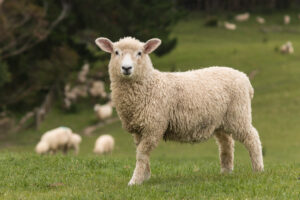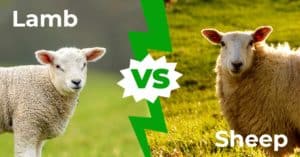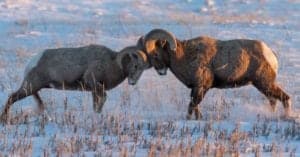Sheep are one of the oldest breeds of domesticated animal in the world. People were keeping sheep long before the Romans came to power. They are still raised the world over for their meat, milk, and wool. But sheep aren’t always called sheep; until they are about a year old, they’re actually called lambs.
Lambs are young sheep, but just what do young sheep eat? Here, we’ll learn about what lambs eat, and how their diet differs from that of adult sheep. Then, we’ll explore just how lambs digest their food, and what their wild counterparts eat. Finally, we’ll go over the specialized diet of domestic lambs, and what they can’t eat.
The Lamb Diet
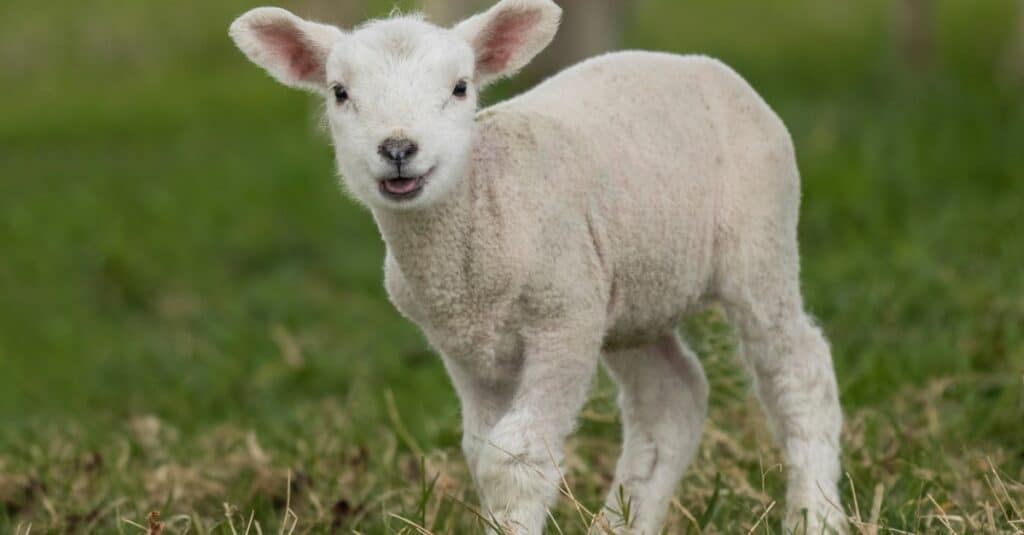
Lambs eat mother’s milk, finely ground supplements, and after four weeks of age, grasses. They are herbivores
©iStock.com/dapec
Lambs eat mother’s milk, followed by finely ground foods and tender forage. They are grazing herbivores, and are normally weaned by two months of age in captivity.
Ewes give birth to lambs after five months of gestation. They normally have 1-2 lambs, but certain species frequently have more lambs per pregnancy. The baby lambs begin standing on their own within one hour of birth.
The first thing the lamb eats is its mother’s colostrum milk. Colostrum milk is different from normal mother’s milk; it contains antibodies and bioactives which get the lamb’s gut bacteria started. The colostrum is vital for the lamb’s digestive system to start developing.
After the colostrum milk, the lamb eats mother’s milk almost exclusively for the first few weeks of life. Lambs will start nibbling on solid foods within a few days of birth, but it is not until they are about one month old that their diet consists of more than 50% solid food.
A Complete List of Foods Lambs Eat
- Mother’s milk
- Soybean meal
- Corn meal
- Alfalfa
- Barley
- Cottonseed meal
- Peanut meal
- Grass
- Woody plants
- Legumes
- Forbs
- Hay
- Grains
The most important part of a lamb’s diet is the protein content. Lambs need a lot of protein (up to 20%) to support their growing muscles. Lambs eat richer foods than adult sheep, including alfalfa, which can cause problems in adult sheep if overconsumed. Lambs can eat treats too. Their favorites include:
- Squash
- Pumpkin
- Pears
- Grapes
- Strawberries
- Apples
- Carrots
- Lettuce
- Pumpkin seeds
- Oats
- Bread–small amounts only
How Do Lambs Digest Their Food?
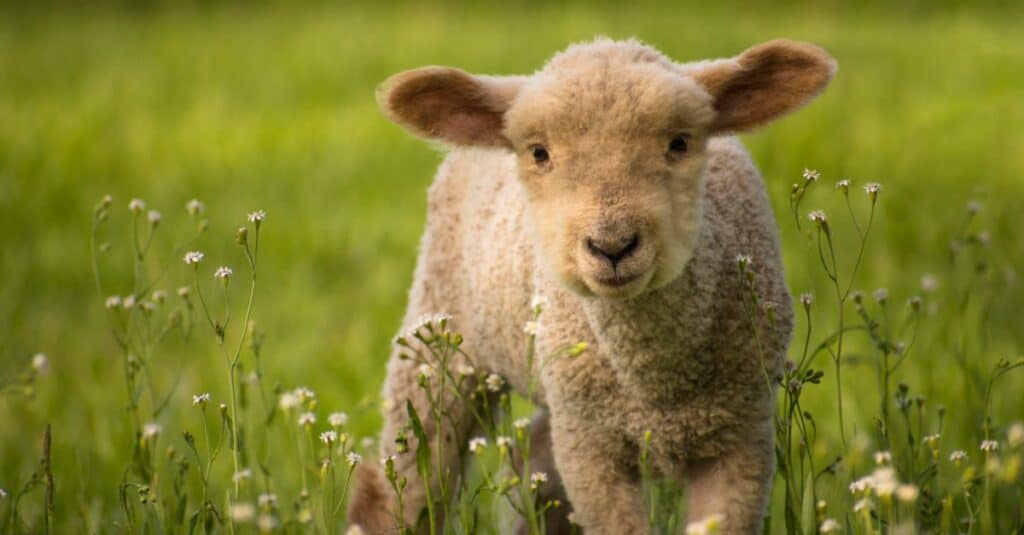
Lambs have a four part stomach that allows them to digest cellulose as early as a few weeks old
©iStock.com/Sebastian Jakimczuk
Lambs are ruminants, which means they have a four part stomach that enables them to digest cellulose. Humans can’t digest cellulose because we don’t have the unique digestive system that lambs have.
It all starts with the teeth. Initially, lambs eat softer foods like tender young grass, or, in the case of many domestic lambs, finely ground meal. As they get bigger, their teeth and digestive systems develop fully, allowing them to eat everything the adult sheep eat. Lambs, and sheep, have no upper teeth in the front. Instead, they have a thick, fleshy pad where their front teeth would be. They use this pad, in combination with their bottom front teeth, to pull grass and leaves from the ground. Then, they chew it up with their heavy back molars.
Once the lamb has chewed the grass, they swallow it and it goes into the first chamber of their stomach; the rumen. Here, the food is fermented by bacteria. Then, the lamb regurgitates the food, now called a bolus, and chews and swallows it again. The chewed up bolus (cud), goes back through the rumen, through the reticulum, omasum, and abomasum, before finally passing through to the intestines.
What Do Wild Lambs Eat?
There are still some species of wild, undomesticated sheep. These sheep do not have the benefit of human intervention when it comes to ensuring that the lambs get enough to eat. Wild lambs eat their mother’s milk for the first few weeks of life, but may begin incorporating solids into their diet earlier than their domestic counterparts.
Unlike domestic lambs, wild lambs are not made to wean early, and usually don’t fully wean until they are around four months old. Though this is also dependent on what time of year the lamb is born, the availability of food, and the ewe’s milk producing capacity.
Interestingly, both wild and domestic ewes teach their young what kinds of food are good to eat, and which aren’t. The younger the lamb, the more it listens to its mother.
What Do Captive Lambs Eat?
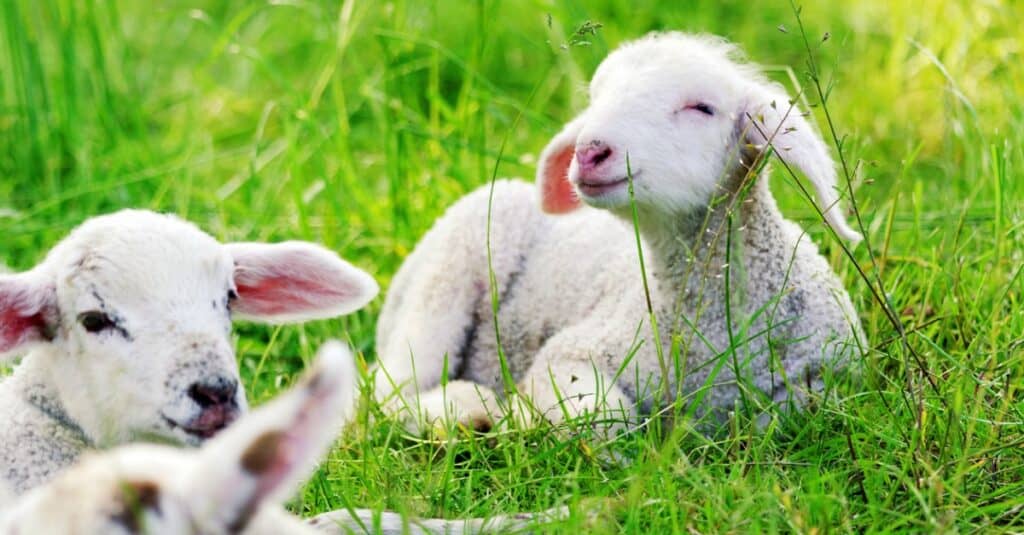
Domestic lambs are fed supplemental foods like cornmeal, soymeal, and alfalfa
©iStock.com/Matthäus Rojek
Domestic lambs are raised for either young lamb meat, mature lamb meat (mutton), wool, or milk. Farmers often seek to increase productivity by producing more lambs, this means that lambs must be weaned earlier.
In order to accomplish this early weaning, and still maintain healthy lambs, farmers supplement their lambs’ diets with protein rich food. This is called creep feeding. It often includes feeding the lambs soybean, corn, cottonseed, or peanut meal, in addition to alfalfa and barley.
Lambs also need to drink at least one gallon of water per day, more if the weather is hot or dry. Most lambs reach sexual maturity by about six months old for rams and eight months old for ewes, though they are still known as lambs until they are one year old.
Occasionally lambs are born that either fail to feed from the mother, or are rejected by the ewe. In this case, farmers have to either bottle feed the lamb, or foster it with another ewe who can provide it with milk. Very young lambs need milk in order to survive; they cannot digest solid, or gain enough nutrition from it, until they are at least a few weeks old.
Foods That Are Toxic to Lambs
Lambs are grazing herbivores; they’re not too picky about what they eat, as long as it’s low to the ground and suits their taste. They’ve even been used as conservation grazers in areas with invasive species of grass. But there are a surprising number of foods that lambs can’t eat:
- Cherry
- Chocolate
- Some kinds of oak and acorn
- Rhododendron
- Kale
- Avocado
- Nightshades: tomato, eggplant, pepper, tomatillo
- Parsley
- Onion
- Broccoli
- Cauliflower
- Cabbage
- Brussel sprouts
- Turnips
The photo featured at the top of this post is © iStock.com/Enjoylife2
Thank you for reading! Have some feedback for us? Contact the AZ Animals editorial team.




